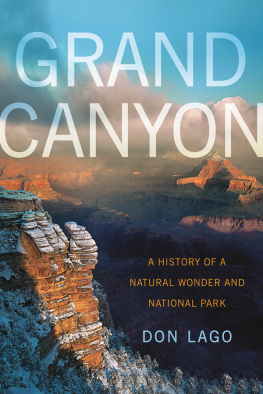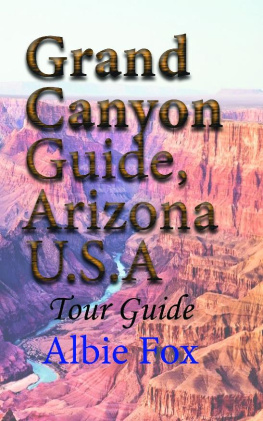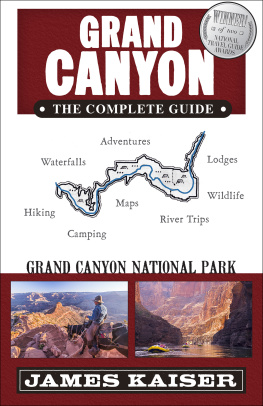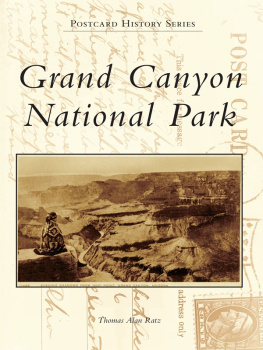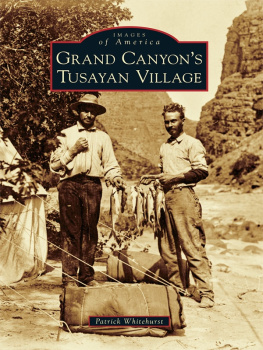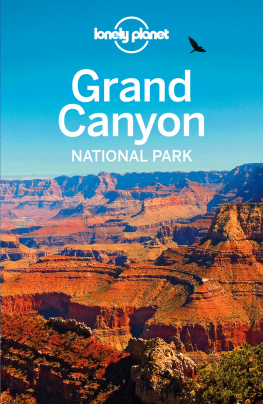All photographs courtesy of the Grand Canyon National Park Museum Collection, unless otherwise noted.
Preface
The Grand Canyon is all about history. It offers the worlds greatest display of geological history, eons of time and events stacked up in an orderly record. Several famous writers, including John Muir and John Wesley Powell, have compared the Grand Canyons rock strata to the pages of a great book.
The Grand Canyon has inspired humans to write hundreds of books about it, including history books. But surprisingly, there have been very few books that offer a general summary of the canyons rich human history. This is not because the canyon lacks this history. On the contrary, just as the canyon is larger-than-life, it has attracted many larger-than-life characters and inspired them to many bold, unlikely deeds.
Yet most Grand Canyon history books have been about specialized aspects of it. River running, in particular, is a dramatic, world-class story that continues to inspire new books. Other canyon history books have focused on topics such as Native Americans, American pioneers, the Santa Fe Railway, art, or a few charismatic individuals like John Wesley Powell. Readers looking for a comprehensive yet concise book on Grand Canyon history that covers everything from its geology to the array of interesting characters it has attracted could not find anything at all. This book fills that void. It is for both canyon visitors and history lovers who would like to know the whole story, something about everything. This book was written to be both intellectually sophisticated and enjoyable storytelling. It will be helpful to visitors who have only a day or two at the park and want to have a richer experience of the canyon. The canyon becomes deeper when you know the stories it holds.
Historians have tended to define history as national history, the story of American exploration, pioneering, and settlement. Real history was mainly about politics and economics. Grand Canyon history books have tended to follow this tradition. They have treated Native Americans as a mere prelude to real history, and they largely left out the stories ofscientists, artists, architects, writers, poets, hikers, and river runners encountering the canyon. Yet while the canyons pioneer days contain some lively people and stories, it was the scientists, cultural leaders, adventurers, and conservationists whose visions of the Grand Canyon have defined the way we experience it today. This book offers a broader view of history, in which the prospectors shovel graduates into the artists brush and the rafters oars. The physical exploration of the canyon was only the beginning of the cultural exploration of it.
The Grand Canyon is an enormously complex place, and no one can be an expert on all aspects of it. Yet the canyon has inspired some brilliant people to devote years or careers to it, and this book has benefited from their knowledge and enthusiasm.
Kim Besom, Mike Quinn, and Colleen Hyde of the Grand Canyon National Park Museum Collection are a great asset to the park and to researchers; Mike was especially helpful in finding some of the photographs for this book. Karen Greig did invaluable research in the Bancroft Library. Richard Quartaroli, formerly of Cline Library Special Collections at Northern Arizona University, reviewed this manuscript and made good suggestions and plucked out some errors, but of course any remaining errors are entirely my own.
I appreciated the time, interest, and contributions of Earle Spamer, Mike Anderson, Mary Williams, Roger Clark, Larry Stevens, Linda Jalbert, Jim Babbitt, Terra Waters, Wayne and Helen Ranney, Tom Martin, Hazel Clark, Alan Petersen, Jerry Snow, Bruce Aiken, Jan Balsom, Ellen Brennan, Amy Horn, Brad Dimock, Drifter Smith, Kim Crumbo, Roy Webb, Greg Woodall, Lynn Hamilton, Dave Wegner, Tom Bean, Susan Lamb, Dan and Diane Cassidy, Keith and Nancy Green, Richard and Sherry Mangum, Erik Berg, Lee Lansing, Sharon Hester, Jacqita Bailey, Marker Marshall, Vince Welch, Al Richmond, Antoinette Beiser, Kevin Schindler, Alfredo Conde, Sheri Curtis, Stewart Aitchison, Bruce Shaw, Ron and Pat Brown, Tom Myers, Julie Russell, Stew Fritts, Stephen and Lois Hirst, Matt Goodwin, Michael Ghiglieri, Mary Lois Brown, Virginia Martin, Al Richmond, Henry Karpinski, Marie Jackson, Steve Verkamp, Mike Verkamp, Susan Verkamp, Shane Murphy, and Betty Upchurch.
This book was the idea of Matt Becker at the University of Nevada Press, and I thank him and the rest of the press for guiding the idea into solid form and Annette Wenda for her able editing.
Introduction
Reverence and Conquest
Better than anywhere else on Earth, the Grand Canyon offers a deep lookliterallyinto the forces of creation, into time, geological events, and biological evolution. Nowhere else is Earths history so well preserved and presented. Other national parks and natural wonders offer only a page or two of this story. They offer one volcanic mountain, or some petrified logs, or a granite valley carved by glaciers in a few seconds by the Grand Canyons timescale. Instead of a few pages of Earths story, the Grand Canyon throws the book at you.
The Grand Canyon is also a larger-than-life place for the life that lives there, including humans. The canyon is enormous with challenges. Most animals and plants could not live there. The canyon requires bighorn sheep that can leap up cliffs, condors that can go for two weeks without a meal, and plants that can withstand 120-degree heat and go for months without rain. The canyon also requires extraordinary people; it is a difficult place for humans to explore or to live. Even the Native Americans who lived there found it a demanding home. Most American prospectors took one look into the canyon, saw the trouble it would demand, and turned around and left for easier places. Most artists and poets quickly recognized the futility of trying to portray the canyon. Every year hikers accustomed to easier landscapeseven the Rockies or Alpssuffer terribly in the canyon, and some die. River runners with decades of experience feel a beginners fear when facing the thunder of Lava Falls.

